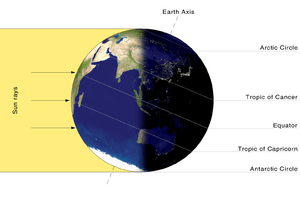Circle of latitude facts for kids
Imagine a giant, invisible hula hoop around the Earth! That's kind of like a circle of latitude. It's an imaginary circle that goes all the way around our planet from east to west. Every spot on one of these circles has the exact same latitude. Your longitude tells you where you are along that circle.
These circles are often called parallels because they are always parallel to each other. They never touch or cross, just like parallel lines in math!
Contents
What Are the Main Circles of Latitude?
There are five very important circles of latitude that scientists and geographers use. They help us understand different climate zones and locations on Earth. Let's look at them, starting from the north and moving south:
The Arctic Circle
The Arctic Circle is located at 66° 33′ 38″ North. This circle marks the southern edge of the Arctic region. If you are north of the Arctic Circle, you can experience days where the sun never sets in summer, and days where it never rises in winter!
The Tropic of Cancer
The Tropic of Cancer is found at 23° 26′ 22″ North. This special line marks the northernmost point where the sun can appear directly overhead at noon. This happens once a year during the summer solstice in the Northern Hemisphere.
The Equator
The Equator is the biggest and most famous circle of latitude. It's located at 0° latitude, right in the middle of the Earth. The Equator divides our planet into the Northern Hemisphere and the Southern Hemisphere. Countries near the Equator usually have warm climates all year round.
The Tropic of Capricorn
The Tropic of Capricorn is at 23° 26′ 22″ South. Just like the Tropic of Cancer, this line marks the southernmost point where the sun can be directly overhead at noon. This occurs during the summer solstice in the Southern Hemisphere.
The Antarctic Circle
The Antarctic Circle is located at 66° 33′ 38″ South. This circle marks the northern edge of the Antarctic region. Similar to the Arctic Circle, areas south of this line experience days of continuous daylight in summer and continuous darkness in winter.
Why Are Circles of Latitude Important?
Circles of latitude are super important for many reasons!
Understanding Climate Zones
These circles help us understand the different climate zones on Earth. For example, the area between the Tropic of Cancer and the Tropic of Capricorn is called the tropics. This region is generally warm and humid. Areas closer to the Arctic and Antarctic Circles are much colder.
Sailors, pilots, and even your phone's GPS use latitude and longitude to figure out exact locations. Circles of latitude are a key part of this global grid system. They help us create accurate maps and navigate around the world.
Daily Life and Seasons
The tilt of the Earth's axis, combined with these circles, explains why we have seasons. The Tropics show how far north or south the sun's direct rays reach, which affects temperatures and daylight hours throughout the year.
See also
 In Spanish: Paralelo para niños
In Spanish: Paralelo para niños


